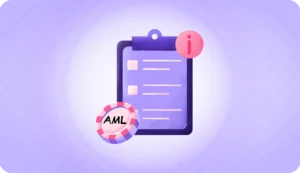Source of funds and Source of wealth are both important verification tools when it comes to AML. Therefore, understanding the difference between them is also very important.
Simply put, the source of funds verification reveals the reason for any single unusual transaction. Whereas, the source of wealth reveals an individual’s entire wealth portfolio.
Both help to understand an individual’s risk profile. Financial institutions verify SOF and SOW to confirm if the client’s funds aren’t linked to illegal or risky sources.
Besides this, SOF and SOW verification is an important step of the overall KYC (Know Your Customer) process. It helps businesses comply with AML (Anti-Money Laundering) and ATF (Anti-Terrorist Funding) regulatory requirements.
This article thoroughly dissects these concepts, diving into their differences and vital importance for financial sectors.
Source of funds
Source of Funds (SOF) refers to the origin of the specific funds used in a particular transaction. It’s about tracing the immediate history of the money being used.
Types of SOF include:
- Savings from Salary
- Proceeds from asset sales
- Business profits
- Loans or credit
- Investment returns
- Selling stocks or earning dividends
- Winning bets and lottery
Example: A client deposits $50,000 into their account. The SOF might be selling their car.
Financial institutions will ask for the following:
- Bill of sale
- Bank statement for transfer record
Source of wealth
Source of Wealth (SOW) is a broader term. It covers all the activities that generated a person’s total assets over time. SOW provides context for a client’s overall financial profile.
Types of SOW include:
- Professional earnings
- Business ownership
- Inherited properties
- Long-term investments
- Real estate appreciation
Example: A high-net-worth individual’s SOW might include their successful tech startup exit, family inheritance, and portfolio of rental properties.
Financial institutions will ask for multiple documents, depending on client type.
For startup
- Startup registration documents
- Most recent ITR filings
- A brief description of what startups do
- Copy of document mentioning terms of sale
For inheritance
- The details of a person whose property has been inherited
- The official date of receiving an inheritance
- Tax records of inheritance
Key differences: SOF vs SOW
The factors below state the clear difference between the Source of Funds and the Source of Wealth.
1. Scope
SOF: It tracks the source of a specific transaction.
SOW: It tracks the source of all financial assets that form a client’s net worth.
2. Timeframe
SOF: It reveals immediate or most recent transactions.
SOW: It reveals the complete financial history over the years.
3. Purpose
SOF: It aims to understand, where the money for a particular transaction came from.
SOW: It aims to understand, how the client amassed their entire wealth.
4. Documentation
SOF: It usually requires bill receipts, loan agreements, or bank statements.
SOW: It usually requires business-related documents, tax records, or investment statements.
5. Mode of assessment
SOF: It involves monitoring suspicious financial transactions.
SOW: It involves assessing the overall financial background.
Where do SOF and SOW overlap?
While there’s a marked difference between source of funds and source of wealth. But they are intertwined in complex financial transaction loops.
SOF represents the immediate origin of funds for specific transactions. These transactions, over time, can significantly shape an individual’s overall wealth picture – their SOW.
Think of SOF as streams feeding into a lake, with the lake representing SOW. Each “stream” of funds can converge into the “lake” of wealth, over time.
Let’s understand this better with Sarah’s example.
Sarah is a software engineer. Her initial SOF is primarily her salary, which is $100,000 annually. This is straightforward SOF verification for any financial institution.
Now, Sarah has decided to invest 20% of her salary into a diverse stock portfolio every year. After five years, these investments have grown to $150,000 due to compound interest and smart choices. This investment account becomes a new SOF for Sarah, allowing her to make larger purchases or investments.
Ten years down the line, Sarah uses funds from this investment account (SOF) as seed money to start her own tech company. The company thrives, and five years later, she sells it for $5 million.
At this point, Sarah’s SOW has largely changed. It now includes:
1. Her original salary (continuing SOF)
2. Her investment portfolio (grown from the original SOF)
3. The proceeds from her company sale (new SOF that significantly boosted her SOW)
Hence, SOF can contribute to SOW over time. Conversely, SOW influences future SOF by providing resources for transactions.
For financial institutions, understanding this progression is crucial. What started as a simple SOF (salary) contributed to various investment decisions, which in turn led to a substantial boost in SOW.
This example illustrates why ongoing SOF verification of financial behavior is vital. It allows institutions to track the logical progression of wealth accumulation. They can investigate those sudden, unexplained jumps in wealth (which could indicate illicit activities in some cases).
Hence, SOF is not just about individual transactions. It’s also about viewing the complete picture of a customer’s legitimate wealth creation over time. This perspective allows for more nuanced risk assessment and better customer relationship management.
How does the source of funds verification work?
Key steps in SOF verification are:
1. Document collection (e.g., bank statements, payslips)
2. Transaction monitoring
3. Cross-referencing with declared income sources
4. Risk-based customer profiling
Here’s how these steps form the effective SOF verification process:
Collect relevant documents
Start by gathering relevant business financial statements and documents. Besides asking for standard items, tailor your documentation requests based on the client’s profile. A business owner might provide different documents than a salaried employee.
Analyze transaction patterns
Look beyond instantaneous numbers. Analyze transaction patterns over longer periods. Sudden large deposits or frequent round-number transactions could be red flags.
Evaluate profiles contextually
Compare the SOF against the client’s profile. Does a junior employee’s SOF match their declared income? If not, there might be a more legitimate source of explanation. Or, a risk to assess.
Adopt a risk-based approach for customer profiling
Apply greater scrutiny to high-risk scenarios like large transaction amounts, payments to countries with weak AML laws, or complex transaction structures.
Perform EDD for high-risk profiles
Screening sanction lists, doing adverse media checks, and other EDD checks became essential in the case of high-risk customers. Often, these are business owners, people from political backgrounds, and individuals having high net worth.
Expert tips for effective SOF verification
Switch to tech-enabled verification
An exhausted employee after verifying 10+ client documents in a day might miss a tiny detail while analyzing further documents. Your staff might approve altered documents. And your platform becomes a hotspot for fraud, money laundering, drug trafficking, or other crimes.
AI and machine learning tools solve this challenge. They spot subtle patterns and intricate details humans might miss. With a tech-powered process, you can verify the source of illicit funds, with higher speed and accuracy.
Keep your clients engaged throughout the process
SOF verification processes can be lengthy and frustrating for clients in some cases. To prevent drop-offs, implement simple and interactive application forms.
Tools like HyperVerge enable businesses to reduce drop-offs —customize UI/UX design, insert progress bars in onboarding forms, and send email/SMS/WhatsApp notifications to resume the application from where the customers leave it—to boost your retention rates.
Monitor accounts regularly with variable frequency across different risk levels
Set monitoring frequency as per customer risk levels. A low-risk customer can be subjected to annual reviews. While the ones on the higher end of the risk spectrum require it quarterly.
This helps you focus 80% of your resources on the 20% of transactions that pose the highest risk. So you can optimize efficiency without compromising thoroughness.
Collaborate across departments
The Source of Funds verification isn’t just for compliance teams. Involve customer service, sales, and even product development to create a holistic approach.
For instance, customer-facing staff often have valuable insights into client behavior. They can help to strengthen the database of your automated system by feeding information about newer and rarer suspicious activity patterns.
Stay updated on trends
Financial crime mechanisms keep evolving. Stay ahead by regularly updating your team on new SOF concealment methods.
Effective source of funds verification is about balance – between compliance and customer experience, between thoroughness and efficiency. Striking this balance helps you keep away all kinds of risk without sacrificing potential revenue opportunities.
Benefits of source of funds verification
With rigid SOF verification frameworks in place, financial institutions can strengthen their KYC/AML policies, risk management, and customer relationships.
1. Mitigates risk of financial crimes
SOF enables you to pinpoint potential money laundering or terrorist financing attempts and protect your organization from consequent losses.
2. Protects your business reputation
Stringent compliance procedures and due diligence protocols demonstrate your commitment to regulatory compliance and ethical business practices.
3. Builds trust with customers
Transparent processes enhance a customer’s confidence in your company, which helps you attract and retain genuine customers for longer.
The indispensable role of SOF verification in overall risk management
Source of funds verification is one of the primary steps in the onboarding stage. It is your first line of defense against fraud, financial crimes, and other risks.
By thoroughly vetting the origin of funds, you’re not only ticking the compliance and regulatory considerations’ boxes. You’re also shielding your business against financial crimes. This proactive approach can save millions in potential fines and reputational damage.
When you filter risky profiles right from the beginning. You set the roadmap for further investigation. This helps you make informed decisions, on whether to refrain a particular customer from accessing your services. Or to stay hyper-vigilant while doing a business relationship with them.
Further, a well-structured SOF process signals trustworthiness to your clients. It tells them, you care about the integrity of your financial system. This trust translates into customer loyalty and positive word-of-mouth marketing, which no paid ads can buy.
Leave behind your concerns about SOF verification challenges and AML compliance with a software, thoughtfully built for financial sector businesses. Thrive through all identity verification risks and challenges with Hyperverge’s advanced AML solutions.
- Scan through global sanction lists within minutes.
- Perform real-time adverse media checks while onboarding PEPs (Politically Exposed Persons), HNWIs (High Net Worth Individuals), and other high-risk clients.
- Get accurate outputs with custom filtering based on DOB and country.
- Stay ahead of fraud and crimes with information that refreshes every 7 minutes.
FAQs
What is the difference between Source of Funds and Source of Wealth?
Source of Funds refers to the origin of money for a specific transaction. While the Source of Wealth covers the overall accumulation of assets over time. SOF is transaction-specific and immediate, whereas SOW provides context for a client or individual’s total wealth and entire financial history.
Why is Source of Funds verification important for my business?
Source of Funds verification is vital for business ownership and ensuring regulatory compliance with KYC and AML requirements. It helps mitigate the risk of financial crimes, protects your business reputation, and builds trust with customers. By verifying the legitimacy of funds, you demonstrate commitment to ethical business practices and maintain financial integrity.
How can I conduct Source of Funds verification for my customers?
To conduct Source of Funds verification, request and analyze relevant financial documents such as bank statements, payslips, or investment records. Implement a risk-based approach to allocate more resources for high-value transactions or higher-risk customers. Utilize automated tools for efficiency and train your staff on proper verification procedures to ensure consistent, thorough assessments.





